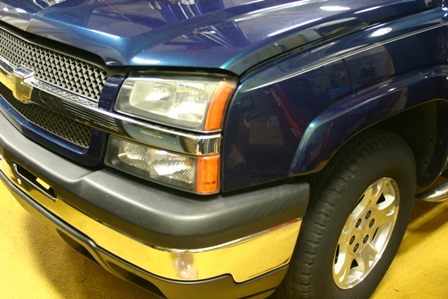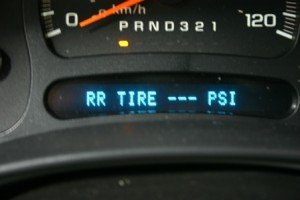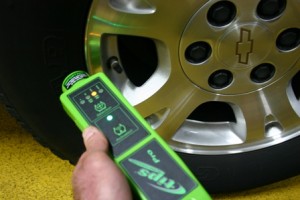TPMS Reset Tool – Chevy Tire Pressure Relearn Procedure
October 24, 2010 7:30 am Chevrolet, Mechanics Tools, TPM Tire Press.© DenLorsTools.com Summary: How to enter the relearn mode and reset the tire pressure monitoring system on a 2006 Chevrolet Avalanche. The repair blog covers a common GM TPM (Tire Pressure Monitoring) system that uses direct pressure readings which displays on the dash. Lower cost alternatives to the Kent Moore J-46079 factory tool are available and shown in the tool repair article. A less expensive tool that can be used to reset GM TPM systems is the TIPS Reset Tool. Questions as to why tire pressure sensors fail to begin with.
Chevy vehicles that display “—” for a certain tire may have a faulty tire pressure sensor.
When the TPM system is working as designed the driver will be warned if a tire becomes low on air. Some will remember Ford Explorers that had a problem of rolling over when tires became low on air; big brother has since moved towards mandates to require tire pressure sensors to help prevent rollovers. When a warning comes on, the tire pressures should be checked ASAP to avoid damaging a tire beyond repair. The Tire Pressure Monitoring Systems that display exact tire pressures in the information center are the “direct” type. They use tire pressure sensors in each wheel, usually built into the tire valve. The Chevrolet Avalanche covered this article utilizes these type of sensors. Direct sensors are not always built into the tire valve. Ford sometimes uses “banded” direct sensors which are mounted on the rim inside the tire 180 degrees opposite of the valve stem. They are attached with a long metal band. Direct type tire pressure sensors use RF (radio frequency) waves to transmit the tire pressure to the ECU (Electronic Control Unit). More accurately the signal usually goes first to the receiver that is also used for the alarm and remote entry. The most common cause of problems on any TPM system is a faulty tire pressure sensor. TPM sensors have batteries that can fail over time like any other battery. TPM sensors are not serviceable which means the battery cannot be changed. When the battery fails the entire TPM sensor has to be replaced. Service technicians must be careful while changing tires when TPM sensors are present because tire machines can easily damage a sensor. Fix-a-Flat tire or similar flat sealers can also damage the sensors. In fact manufacturers recommend replacing any sensor that comes in contact with any liquid like Fix-a-Flat.
Kent Moore J-46079 referred to in the repair manual – TIPS Tool used in image above.
If a scan tool like a Genysis is used, the TPM data can be accessed and viewed. If a sensor is not faulty yet, but has a low battery it will be displayed. This is an early warning that the sensor’s battery will fail soon. If replacing a faulty sensor, it’s a good idea to check to see if any of the other sensors have low batteries as well because they may present problems shortly. This is a good practice because the customer may think that the repair shop is at fault if a warning message re-occurs soon after a sensor replacement. Remember that all the sensors may be the same age and might fail around the same time. At least being able to check the battery status with the scan tool is helpful.
All of the TPM systems have something in common; To reset or relearn the sensors the “learn” mode must be entered. Some systems allow use of the buttons for the information center to enter the learn mode. For instance my wife’s 2007 Impala SS is set up like that. Others like the 2006 Chevrolet Avalanche in this repair blog is entered manually by following the procedure below.
1. Turn the ignition switch ON without starting the engine.
2. Push the parking brake pedal.
3. Switch headlight switch to the parking lights ON position and back off four times within four seconds. If done properly the horn will beep twice quickly. This indicates the learn mode has been entered. The tire pressure indicator will flash rapidly at this time.
4. Always start with the driver’s side front tire. Use the TPM reset tool, regardless of brand, the TIPS tool is pictured above. Hold the Tire Pressure Monitor Reset tool near the tire sidewall of the tire close to the wheel rim (On the Chevy, the sensor is built into the tire valve). Activate the tool by pushing the button and wait for a horn beep.
5. After the horn beep, move on to the passenger side front tire and repeat. Then move to the passenger side rear tire and repeat. Finally move to the driver’s rear tire and repeat the procedure. If at any position the horn does NOT beep, this may indicate a faulty sensor. The non responding sensor can be skipped if needed and the others triggered for testing purposes. In trying the entire procedure over again, if the same sensor will NOT set, this helps to re-affirm a fault with that sensor.
After replacing a sensor and going through the procedure outlined above, the reading for the replaced sensor may read 0 psi for a few minutes. Allow time for the ECU to communicate with the new sensor. The Chevrolet Avalanche relearn procedure for the TPM system may also apply to other Chevy models. For details on specific model and year vehicles, a service manual should be referenced.
Related Repair Blogs and Mechanics Specialty Tools



Pat the Auto Guy :
Date: October 24, 2010 @ 4:33 pm
This is a great tool for quickly finding faulty sensors which is the goal of a good
auto repair shop. It does point out though that while cars nowadays have lots of great features, they all cost money, and the increased complexity also increases maintenance costs. Are the features worth it?
dennisb specialty tool sales :
Date: October 26, 2010 @ 10:28 am
Pat, like it not progress continues if deemed necessary or otherwise. Tire pressure monitors actually make sense though for most people that are too busy to think about checking tire pressures unless they’re prompted by a warning displayed on their dash.
Low tires are more prevalant;
1. Due to self service gas pumps. Remember when full service gas stations cleaned your windshield and checked the tires for you?
2. Synthetic oil changes allow more miles and time to go by between oil changes. This results in more of a chance that low tires go unnoticed.
Something to be said for the old days when service was taken for granted. When will advances in technology be able to warn the driver over worn out tires?
Michael Firstman@ Arc Welders :
Date: November 10, 2010 @ 3:23 pm
It’s true all the modern features on vehicles means more things to keep an eye on. I came across a video from BMW featuring Augmented Reality car repairs. The mechanic wears these AR glasses which instructs him on proper procedures in whichever repair he is undertaking. I think this could be used by regular motorists someday to repair and to just check for any issues their car may have.
Rachel :
Date: June 12, 2012 @ 8:52 pm
My TPS light has been on for 2 years in my 2007 Impala. After reading the above, I feel sure that the valve stem sensors need to be replaced. Is this a DIY, if so, some tips would be great! Thanks!
dennisb - Auto Tool Sales :
Date: June 13, 2012 @ 6:15 am
Rachel, a tire machine is needed to break the bead down to access the valve sensor. So, definitely not a DIY project. Good Luck.
jim b :
Date: March 23, 2015 @ 7:49 pm
Will tire rotation create a faulty location for the sensor reading?
My 2010 Malibu gives left rear as location for right front tire pressure.
dennisb - Auto Tool Sales :
Date: March 24, 2015 @ 7:06 am
Jim, yes. After a rotation on many cars – calibration or resetting is necessary for the locations to be correct. A magnet can sometimes be used, other times a TPMS reset tool is required. Good Luck.